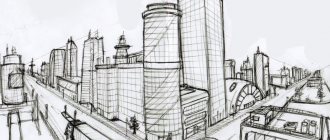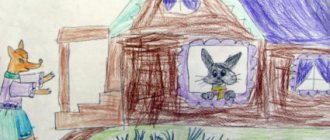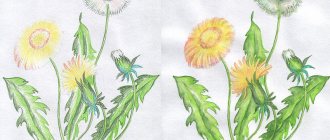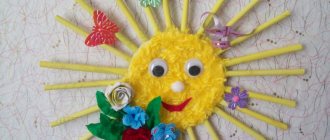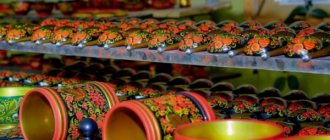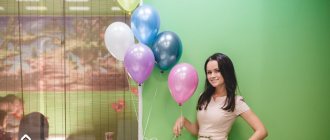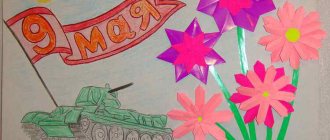Summary of a drawing lesson in the senior group “Introduction to Khokhloma painting”
Zakirova Gulnara Mizfatovna
Summary of a drawing lesson in the senior group “Acquaintance with Khokhloma painting”
Goal: To contribute to consolidating and expanding children’s knowledge about the folk art craft of Russian masters - Khokhloma painting and its features .
Learn to draw "curls"
.
Practice drawing thin smooth lines with the end of the brush.
Improve the ability to create a pattern based on Khokhloma painting on new-shaped products, using the knowledge, skills and abilities acquired in previous lessons in the cycle .
Promote the development of a sense of color, rhythm, composition;
To promote interest in folk arts and crafts and the traditions of the Russian people, a sense of pride in their country and respect for the work of folk craftsmen.
Demonstration material: finished products of Khokhloma masters , samples of elements of Khokhloma painting (sedge, blade of grass, tendrils, droplet, berry)
, a sheet of paper to demonstrate the method of
drawing a “curl” with a drawn main branch (criulem, a sample of a vase with Khokhloma painting .
Handout: ready-made silhouettes of vases tinted yellow, gouache, a jar of water, a napkin, sponge pokes, a brush for each child , sheets for practicing drawing “curls”
.
1. Verbal - a story for children about the origin of Khokhloma products and painting .
2. Visual – examination of products painted with Khokhloma painting , handouts and demonstration materials.
3. Practical – children’s work at tables.
Vocabulary work: "curl"
, criul, vegetation.
Integration with OO:
History of the fishery
There are many legends about how the famous Khokhloma craft originated. The first written historical mentions of the village of Khokhloma date back to the sixteenth century.
Origin - beginning of the 17th century
Even under Tsar Ivan Vasilyevich they knew about the place “Khokhlomskaya Ukhozheya” (Ukhozheya is land cleared of forest, prepared for arable land (obsolete)). The land was infertile. Peasants have long earned their livelihood by carving simple wooden utensils - spoons, pots, bowls, kvass and jugs in the form of birds, boats (ships) and animals. The products were unpainted and coated with drying oil for strength.
Some peasants went to work. Many went to the Trinity-Sergius Lavra, to which the Volga lands and villages were “assigned”. There, craftsmen painted wooden mugs and ladles, gilded cups, served on patronal feasts with gold and cinnabar.
At the beginning of the seventeenth century, Old Believers fled to the Trans-Volga forests, who began to be called “Kerzhaks”. They did not accept the patriarch’s decree, and settled throughout vast Siberia, in the forests of the Trans-Urals. Many settled in the impenetrable thickets of the Volga region. The schismatics brought with them icons, ancient letters, books, and utensils. Among them were icon painters who knew many of the secrets of painting. To survive in harsh lands, they began to decorate wooden utensils.
And simple kitchen utensils from Khokhloma blossomed with beautiful patterns that did not leave a single person indifferent.
Khokhloma in the USSR
Khokhloma production survived the collapse of Tsarist Russia, fell into decline many times and was revived again. After the collapse of the USSR, many workshops stopped working. In modern Russia there are two main production centers - the city of Semenov - the capital of golden Khokhloma, with the Semenovskaya Painting factory and the Khokhloma Painting enterprise. And also the village of Seminos and the production of “Khokhloma Artist”.
In the seventies, masters were invited to Kursk for training. This is how the famous Kursk hand painting was born. At first, the masters painted according to samples, and then their unique features appeared - a green background, a golden border. The rich ornaments of Sujan carpets were embodied in paintings with poppies and wildflowers. Interesting ideas arose for making vases and sugar bowls in the shape of ducks and cockerels.
Painting in blue and cyan on a silver background - a creative discovery of masters from Vologda, began to be called “Northern Khokhloma”. In her drawings with traditional grass, northern berries appear - blueberries, cranberries.
Abstract of OOD on drawing in the senior group “Golden Khokhloma”
Irina Volkova
Abstract of OOD on drawing in the senior group “Golden Khokhloma”
Abstract of OOD on drawing in the senior group
Topic: “ Golden Khokhloma ”
Objectives: Continue to introduce children to products decorated with Khokhloma painting . To consolidate children's knowledge about the color scheme and elements of Khokhloma painting (berries, light curved grass, curl, droplets)
.
Develop aesthetic perception, sense of color, composition. Practice various techniques of working with a brush (all bristles, ends)
. Instill interest in folk crafts.
Materials and equipment
Wooden dishes painted with Khokhloma painting , samples of elements of Khokhloma painting , paper tableware blanks, watercolor paints, brushes, water glasses, napkins, a disc with Russian folk music.
Khokhloma. Khokhloma painting for children.
Khokhloma is an ancient Russian folk craft, born in the 17th century in the Nizhny Novgorod region. An old legend tells: once upon a time there lived a man in the Nizhny Novgorod forests, on the banks of a quiet river. We don’t know who he is or where he came from. The man carved wooden cups and spoons and painted them so that they seemed to be made of pure gold. The king found out about this and became angry: “Why don’t I have such a master in my palace?! Give it to me! Immediately!" He tapped his staff, stamped his foot, and sent soldiers to take the craftsman to the palace. The soldiers set off to carry out the royal order, but no matter how much they searched, they could not find the master’s miracle. He went to God knows where, but first he taught local peasants how to make gold utensils. In every hut cups and spoons sparkled with gold.
The village of Khokhloma, Koverninsky district, Nizhny Novgorod region, is considered the birthplace of Khokhloma.
Products for Khokhloma painting, most often dishes and furniture, are made of wood. But before painting on them, the surface is coated with a primer and shiny oil using a special technology. Then this shiny surface is tinned - aluminum powder is rubbed into it with a soft cloth, from which it becomes silvery and very smooth, and after varnishing - golden. The dishes are painted “Khokhloma” with oil paints. Traditional elements of Khokhloma are red juicy rowan and strawberries, flowers and branches. Birds, fish and animals are also often found.
Red, black, gold and green are the colors of Khokhloma. To liven up the pattern, a little white is allowed.
Painting can be “top” - a design is applied to a silver blank in red and black; and “under the background” - first the outline of the ornament is outlined, and then the background is filled with black paint, while the pattern itself is not painted, but remains silver. When varnished, the silver coating will turn golden and look as if it was made of gold. 
Let's practice horse Khokhloma painting? To do this, you need to print a sheet with the pattern or utensils you like. And there - pick up a brush and paints and go!
Grass is a pattern of large and small blades of grass. Pattern elements: sedges, blades of grass, droplets, tendrils, curls and bushes.
Herbal ornament.
Leaf pattern - stems and leaves.
The berry pattern includes the following ornaments: lingonberry, gooseberry, currant, strawberry, rowan, raspberry.
The “gingerbread” ornament is usually painted inside a cup or dish; it is a geometric figure (square or rhombus) decorated with grass, berries, and flowers.
In painting “under the background” the element “curl” is more often used. Curl painting is a rich, lush pattern with round, intricate curls reminiscent of curls. It is not the patterns themselves that are drawn, but the dark background. And the resulting pattern is supplemented with small colored elements (postscripts). This process is much more labor-intensive than horse painting.
Painted items are coated with a special varnish 4-5 times (with intermediate drying after each layer) and finally hardened for 3-4 hours in an oven at a temperature of +150 +160 °C until a golden-colored oil-varnish film is formed. This is how the famous “golden Khokhloma” is obtained.
Khokhloma: painting, pictures and patterns
There are several types of ornament:
Herbal painting is an ancient type of painting. It is painted with small strokes, curls, spikelets and berries on a silver background.
Reminiscent of Russian grasses - meadow, marsh sedge, white grass.
This pattern can be scattered throughout the product of plates, cutting boards, boxes, or collected in bouquets or bushes. Moreover, from scattered blades of grass, artists create various combinations of pictures - the motif of a rooster, a firebird sitting on a tree, pecking berries, as well as fish.
Painting “like a leaf” or “like a berry” - in addition to grass, it includes oval petals painted with brush strokes and larger strokes.
The base consists of pointed or rounded leaves of three or five, and groups of berries near the stem.
Depending on the size of the product, elements of branches, rowan, grapes, currants, gooseberries, strawberries, chamomile flowers, tulips and bells may be included.
Painting to resemble “gingerbread” or “saffron milk cap” - this ornament is usually used inside a dish or bowl. Geometric shapes fit into a rhombus or square. With grass bushes in the corners, and in the middle - a large “saffron milk cap” in a circle - the sun. Gingerbread is also called “braid”, since braids of herbs and motifs seem to grow out of it. At first, these painting elements seem simple and primitive. But if you look closely, you can see that the sun is moving, and along with it all the leaves and blades of grass are captured in a whirl.
“Kudrina” - stylized golden images of curly curls forming leaves, flowers, berries and fruits. This is a type of painting where the main thing is a contour line, a golden spot and light, thin strokes in drawing small details.
“Background” - the artist draws a stem with flowers and leaves, stylized images of cockerels and fish. The background is then filled in with paint, usually black. On top of the black background, strokes of paint are made - blades of grass, bunches of wild apples and small flowers are stuck on.
Painting under “Gingerbread” Khokhloma under the background Painting “Kudrina”
